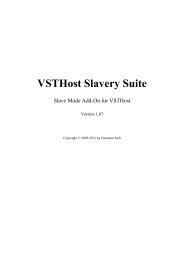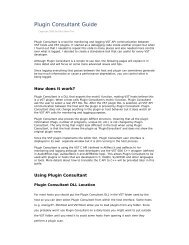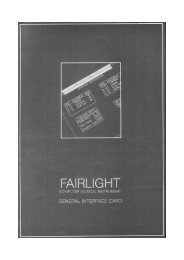VSTHost - Hermann Seibs Hauptseite
VSTHost - Hermann Seibs Hauptseite
VSTHost - Hermann Seibs Hauptseite
Create successful ePaper yourself
Turn your PDF publications into a flip-book with our unique Google optimized e-Paper software.
The Buffer Size combo box lets you select between some buffer sizes; these are carefully selected for<br />
their property that their multiples exactly fit into one second at 44.1kHz. Now, that may be nice, but…<br />
first of all, 44.1kHz isn’t mandatory for ASIO drivers, and some of these mandate other buffer sizes.<br />
Therefore, apart from the predefined values, you can enter any (reasonable) buffer size you want into<br />
this combo box.<br />
Here’s how a sample configuration looks like (this PC uses a Terratec DMX 6fire 24/96 card):<br />
Figure 4: Setup for Terratec DMX 6fire 24/96<br />
Experiment with the buffer size; if it is too large, you’ll hear noticeable delays between the triggering<br />
of a note and its actual appearance at the speakers. If it is too small, the overhead introduced by the<br />
frequent buffer handling might become too much for your poor little computer; in that case, it starts to<br />
skip processing some buffers since it doesn’t have enough time for it. This results in an occasionally<br />
audible crackling noise. In this case, increase the buffer size until it goes away.<br />
Note: if you're switching from an MME or DirectSound driver to ASIO4All, take care. The ASIO4All<br />
driver might try to open the device you just closed, and there are some drivers that don't like this –<br />
they need a little time to pass before re-opening them works. So, in this case, it's better to select “* No<br />
Wave *” for Input and Output Port, close the dialog, reopen it, and then select ASIO4All as output<br />
driver. This should work with all audio drivers, even if they're poorly written.<br />
Once you have configured an ASIO driver, the following two menu entries can be used:<br />
ASIO Control Panel<br />
Here, you can call up the selected ASIO Driver’s configuration panel. This varies greatly between the<br />
various drivers and is not part of <strong>VSTHost</strong>. The <strong>VSTHost</strong> audio engine is stopped while the ASIO<br />
Control Panel is open.<br />
ASIO Channel Selection<br />
Normally, <strong>VSTHost</strong> operates with as many channels as the Wave device drivers permit. If you only<br />
need specific channels, however, you can use this to select a subset of the available stereo pairs to use.<br />
Selecting the menu entry brings up the following dialog:<br />
Figure 5: ASIO Channel Selection Dialog<br />
12





